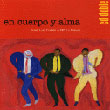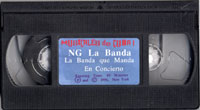Indice - Table of contents
New Stuff[hide]
Musicos: Rafael Paseiro Monzón
Musicos: Dennis Nicles Cobas
Musicos: Jiovanni Cofiño Sánchez
Musicos: Yasser Morejón Pino
Fotos: Tom Ehrlich : 2024 Monterey Jazz, P...
Resenas: Vacilón Santiaguero (Circle 9 ...
Staff: Bill Tilford
Fotos: Tom Ehrlich : 2024 Monterey Jazz, P...
Fotos: Tom Ehrlich : 2024 Monterey Jazz Fe...
Fotos: Tom Ehrlich : testing 123
Grupos: Pupy y los que S... : Discography - 1995- F...
Reportes: From The St... : Cubadisco 2...
Reportes: From The St... : Jazz Plaza ...
Fotos: Tom Ehrlich : Irakere 50th Annivers...
Photos of the Day [hide]
SpanishEnglishDiscography - 1991-En cuerpo y el alma
 LIVE - En Cuerpo y Alma - This 2-disc set of live recordings from both Japan and Italy is extremely fascinating for the NG connoisseur for a number of reasons. It has very little printed information and wasn’t released until 1997, but the material indicates that it had to have been recorded between 1991 and 1992; it has Calixto and Mena, so it’s after the Piloto/Issac group, but they’re still playing the early period’s material, so it’s before "échale Limón". It’s very interesting for a variety of reasons including comparing the drumming styles of Piloto and Calixto and the vocal styles of Issac and Tony Calá, who took over the lead vocals on two Issac standards, "La Expresiva" and "Los Sitios Entero", which opens the Japanese segment. Amazingly, the timing is rushed and jittery at the outset, providing a rare opportunity to hear these godlike virtuosos playing as if they might actually be human! This rare lapse last only a few bars - by the first coro the band is hitting on all cylinders. It’s possible that this isn’t too long after Issac’s departure and that this may one of Calá’s first performances of the vocal. The tempo, which was already fast on the studio version (106 BPM), is taken at a breakneck speed of 118 BPM. Calá follows the basic outline of Issac’s recorded guías but phrases them in his own style, especially during the rumba section. After the rumba, he goes completely into his own guías which makes the comparison with Issac even more interesting. Next is a short but fiery version of "Que Venga la Fiera". The metales are magnificent on the anthem-like introduction, with the wonderfully in-tune saxes laying the foundation for the high, soaring trumpet lines. Next is an 18-minute version of "Cha Cortés" with Tosco conducting a breathtaking tour de force of virtuoso flute-playing. In the extensive unaccompanied sections he pulls out all of the tricks - singing into the flute in harmony with what he plays, playing percussion with the pads, etc. - but even the flashiest parts have intelligent, in-tune musical content. "Merengue Españo" is a three minute romp based on the archetypical flamenco chord progression. "Por Que Tú Sufres" gets an extended treatment, with a long piano solo from Peruchín. The spirited version of "All of Me" is quite a taken a bit faster than the later studio recording on "La Bruja". It features a long scat-singing solo from Calá, which is interesting, but Sarah Vaughan, were she still alive, would not feel threatened! Scatting is one of the few elements of Jazz that NG had not completely devoured and made their own. The Japanese disc ends with "No Se Puede Tapar el Sol" which features an extensive audience participation section. It almost sounds as if the recording has been doctored -- the Japanese crowd, sounding as good as the Mormon Tabernacle Choir, is able to mimic everything Tony and Tosco throw at them, with excellent pitch and rhythm, even when Tosco asks them to whistle his flute licks back!.
LIVE - En Cuerpo y Alma - This 2-disc set of live recordings from both Japan and Italy is extremely fascinating for the NG connoisseur for a number of reasons. It has very little printed information and wasn’t released until 1997, but the material indicates that it had to have been recorded between 1991 and 1992; it has Calixto and Mena, so it’s after the Piloto/Issac group, but they’re still playing the early period’s material, so it’s before "échale Limón". It’s very interesting for a variety of reasons including comparing the drumming styles of Piloto and Calixto and the vocal styles of Issac and Tony Calá, who took over the lead vocals on two Issac standards, "La Expresiva" and "Los Sitios Entero", which opens the Japanese segment. Amazingly, the timing is rushed and jittery at the outset, providing a rare opportunity to hear these godlike virtuosos playing as if they might actually be human! This rare lapse last only a few bars - by the first coro the band is hitting on all cylinders. It’s possible that this isn’t too long after Issac’s departure and that this may one of Calá’s first performances of the vocal. The tempo, which was already fast on the studio version (106 BPM), is taken at a breakneck speed of 118 BPM. Calá follows the basic outline of Issac’s recorded guías but phrases them in his own style, especially during the rumba section. After the rumba, he goes completely into his own guías which makes the comparison with Issac even more interesting. Next is a short but fiery version of "Que Venga la Fiera". The metales are magnificent on the anthem-like introduction, with the wonderfully in-tune saxes laying the foundation for the high, soaring trumpet lines. Next is an 18-minute version of "Cha Cortés" with Tosco conducting a breathtaking tour de force of virtuoso flute-playing. In the extensive unaccompanied sections he pulls out all of the tricks - singing into the flute in harmony with what he plays, playing percussion with the pads, etc. - but even the flashiest parts have intelligent, in-tune musical content. "Merengue Españo" is a three minute romp based on the archetypical flamenco chord progression. "Por Que Tú Sufres" gets an extended treatment, with a long piano solo from Peruchín. The spirited version of "All of Me" is quite a taken a bit faster than the later studio recording on "La Bruja". It features a long scat-singing solo from Calá, which is interesting, but Sarah Vaughan, were she still alive, would not feel threatened! Scatting is one of the few elements of Jazz that NG had not completely devoured and made their own. The Japanese disc ends with "No Se Puede Tapar el Sol" which features an extensive audience participation section. It almost sounds as if the recording has been doctored -- the Japanese crowd, sounding as good as the Mormon Tabernacle Choir, is able to mimic everything Tony and Tosco throw at them, with excellent pitch and rhythm, even when Tosco asks them to whistle his flute licks back!.
The second disc is recorded in Milan, Italy. It starts with a partially abbreviated version of "La Expresiva" in which the coros are altered to include various Italian neighborhoods in the list of barrios. It’s the second opportunity to hear Calá sing a song previously sung by Issac. It’s also very interesting to compare Calixto Oviedo’s drumming to Piloto’s studio recording. Note his use of the snare drum, which he hits on the second note of the "2" side of the clave. In the opening section, which is in 2:3, you hear it on the second beat, and later in the song, when the clave has changed to 3:2, the snare starts hitting on the fourth beat. In Rock or Funk, of course, it would hit on both of these "backbeats", but in Timba, the placement of the snare is frequently tied to the clave. We’re not sure if this snare pattern started with Calixto but it became very common in the years that followed. "Me Voy Pa’l Pueblo", a traditional-sounding Cha-Cha, is from the album "Para Curaçao". This live version features a long teclado solo from Miguelito Armas. "Asesina" finds Miguelito having fun with his sampler. He has a sample of what sounds like Mena saying "Asesina" which he’s mapped to the keyboard and plays at different pitches. The song, probably written during the tour, is really just one funky groove with Tosco rapping over the top, a couple horn sections and a different coro section with Calá singing guías. Perhaps the most fascinating track on the whole 2-disc set is "Señorita Italiana" which offers a glimpse into the creative process and the way a classic arrangement gradually develops over time. It starts with the groove that would later be used for one of NG’s greatest songs, "Picadillo de Soya". In this case, Tosco’s rap is about Italian women instead of soybeans, but you can hear the origins of some of the ideas he later used on "Picadillo de Soya" ("talla, talla…tremenda talla"). The piano montuno is also an early prototype of the one used on "Picadillo". On this disc we hear the post-Piloto/post-Issac group playing the earlier group’s hits while beginning to find its own sound, which would come to full creative fruition in the great albums of the next few years. The last half of the arrangement takes an instrumental turn, featuring great solos from all four horn players, one at a time and then together, and then a rare Calixto Oviedo solo on drums. The next track is simply called "Flute Solo" - more incredible unaccompanied flute wizardry from Tosco, with sprinklings of accompaniment from Arango and Oviedo. "Ponle el Biberón" looks all the way back to the first album, and the disc concludes with "To’ el Mundo e’ Bueno, Camará" from "En la Calle".
 VIDEO - Musicales de Cuba - La Banda Que Manda en Concierto -- This commercially available 45 minute video is a real gem. The recording quality and camera work are very professional and it contains two complete songs by the seminal group which recorded "En la Calle" - Issac, Piloto, Wickly, plus all the regulars. They do "Necesito una Amiga" and a very long version of "Por Qué Tú Sufres". There’s also an very old and very rare clip of the pre-Issac group playing "Te Regalaré mi Mejor Canción" in a Panamanian television studio, with Victor Valdés singing lead and Tosco playing congas. The video concludes with a live (although incomplete) version of "Échale Limón" in Japan with Calixto Oviedo on drums. We strongly recommend this video for both NG fanatics and those just getting into the group. Warning: Make sure you get the real Musicales version and not the Marakka2000 pirated version which has markedly inferior quality.
VIDEO - Musicales de Cuba - La Banda Que Manda en Concierto -- This commercially available 45 minute video is a real gem. The recording quality and camera work are very professional and it contains two complete songs by the seminal group which recorded "En la Calle" - Issac, Piloto, Wickly, plus all the regulars. They do "Necesito una Amiga" and a very long version of "Por Qué Tú Sufres". There’s also an very old and very rare clip of the pre-Issac group playing "Te Regalaré mi Mejor Canción" in a Panamanian television studio, with Victor Valdés singing lead and Tosco playing congas. The video concludes with a live (although incomplete) version of "Échale Limón" in Japan with Calixto Oviedo on drums. We strongly recommend this video for both NG fanatics and those just getting into the group. Warning: Make sure you get the real Musicales version and not the Marakka2000 pirated version which has markedly inferior quality.























